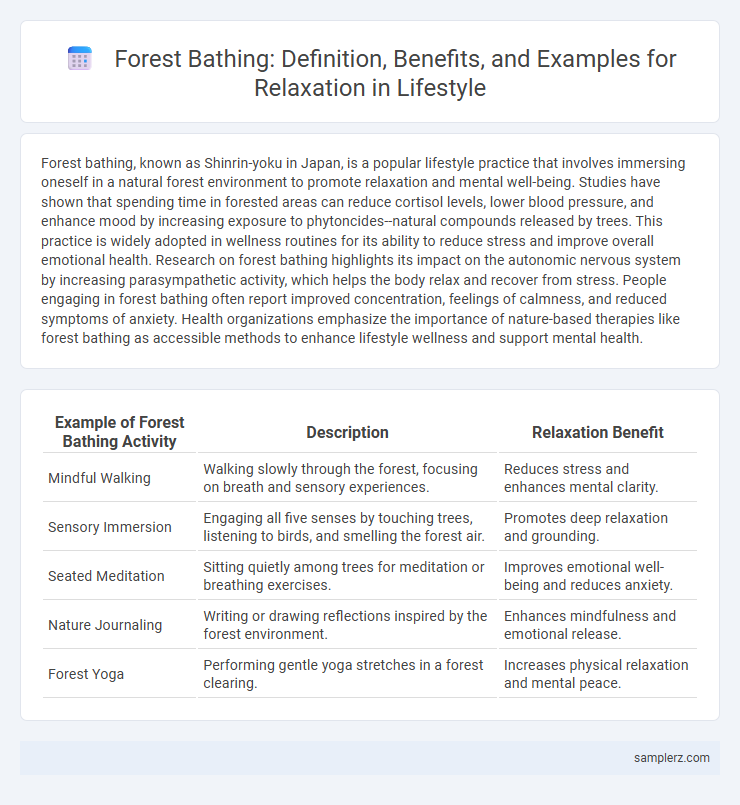Forest bathing, known as Shinrin-yoku in Japan, is a popular lifestyle practice that involves immersing oneself in a natural forest environment to promote relaxation and mental well-being. Studies have shown that spending time in forested areas can reduce cortisol levels, lower blood pressure, and enhance mood by increasing exposure to phytoncides--natural compounds released by trees. This practice is widely adopted in wellness routines for its ability to reduce stress and improve overall emotional health. Research on forest bathing highlights its impact on the autonomic nervous system by increasing parasympathetic activity, which helps the body relax and recover from stress. People engaging in forest bathing often report improved concentration, feelings of calmness, and reduced symptoms of anxiety. Health organizations emphasize the importance of nature-based therapies like forest bathing as accessible methods to enhance lifestyle wellness and support mental health.
Table of Comparison
| Example of Forest Bathing Activity | Description | Relaxation Benefit |
|---|---|---|
| Mindful Walking | Walking slowly through the forest, focusing on breath and sensory experiences. | Reduces stress and enhances mental clarity. |
| Sensory Immersion | Engaging all five senses by touching trees, listening to birds, and smelling the forest air. | Promotes deep relaxation and grounding. |
| Seated Meditation | Sitting quietly among trees for meditation or breathing exercises. | Improves emotional well-being and reduces anxiety. |
| Nature Journaling | Writing or drawing reflections inspired by the forest environment. | Enhances mindfulness and emotional release. |
| Forest Yoga | Performing gentle yoga stretches in a forest clearing. | Increases physical relaxation and mental peace. |
Discovering Forest Bathing: A Pathway to Deep Relaxation
Forest bathing, or shinrin-yoku, immerses individuals in woodland environments to naturally reduce stress and enhance mental clarity. Studies show that spending just 20 minutes in a forest can lower cortisol levels and improve heart rate variability, promoting relaxation. This practice encourages mindful sensory engagement with nature, fostering a profound sense of calm and focus.
Essential Elements of Forest Bathing for a Calmer Mind
Forest bathing immerses the senses in towering trees, fresh air, and the soothing sounds of nature, promoting deep relaxation and mental clarity. Key elements include mindful breathing, gentle walking on forest trails, and intentional observation of natural surroundings to reduce stress hormones. Regular practice enhances mood, lowers cortisol levels, and improves focus by reconnecting the mind with the calming effects of greenery and natural light.
Step-by-Step Guide to Experiencing Forest Bathing
Forest bathing, or shinrin-yoku, involves immersing oneself in a natural forest environment to enhance relaxation and mental clarity. Begin by choosing a quiet forest trail, remove distractions such as phones, and walk slowly while engaging all your senses to notice the sights, sounds, and smells. Conclude the experience with a brief seated meditation or deep-breathing session to deepen calmness and focus before returning to daily life.
Real-Life Forest Bathing Routines for Stress Relief
Forest bathing routines for stress relief typically involve immersing oneself in natural surroundings, such as walking slowly through dense woodlands while paying close attention to the sights, sounds, and smells of the forest environment. Studies indicate that spending at least 20 minutes in nature can reduce cortisol levels, lower blood pressure, and enhance mental clarity. Incorporating mindful breathing exercises and gentle stretching during these sessions amplifies relaxation and promotes a profound sense of calm.
Top Forest Bathing Spots for Ultimate Relaxation
Shinrin-yoku, or forest bathing, enhances mental clarity and reduces stress through immersive nature experiences. Top forest bathing spots like Yakushima Island in Japan, Hallerbos in Belgium, and the Olympic National Forest in the USA offer serene environments rich in biodiversity ideal for deep relaxation. These locations provide lush greenery, tranquil sounds, and fresh air that stimulate mindfulness and promote overall well-being.
Mindfulness Practices While Forest Bathing
Forest bathing enhances relaxation by immersing individuals in natural environments, promoting mindfulness through focused sensory awareness of sights, sounds, and scents. Engaging in intentional breathing and slow walking during forest bathing deepens present-moment attention, reducing stress and improving mental clarity. Studies show that mindfulness practices in forest settings lower cortisol levels and increase parasympathetic nervous system activity, amplifying restorative benefits.
Forest Bathing Techniques to Enhance Your Well-Being
Forest bathing techniques such as mindful breathing, gentle walking, and sensory immersion in nature enhance relaxation and mental clarity by reducing cortisol levels and promoting parasympathetic nervous system activation. Engaging with natural environments through deliberate observation of trees, sounds, and scents improves focus and emotional resilience. Regular practice of these methods supports overall well-being by lowering stress markers and increasing serotonin production.
Transformative Relaxation Stories from Forest Bathing
Forest bathing, an ancient Japanese practice known as shinrin-yoku, immerses individuals in natural forest environments, promoting profound relaxation and mental clarity. Participants often report transformative experiences, including reduced cortisol levels, enhanced mood, and heightened focus through mindful engagement with the sensory elements of the forest. Scientific studies confirm that regular forest bathing sessions can improve cardiovascular health, boost immune function, and foster lasting stress resilience.
Combining Forest Bathing with Daily Wellness Habits
Forest bathing, a practice rooted in Japanese tradition known as Shinrin-yoku, enhances relaxation by immersing the senses in natural forest environments, reducing cortisol levels and promoting mental clarity. Combining forest bathing with daily wellness habits like mindfulness meditation, deep breathing exercises, and gentle yoga amplifies stress reduction and improves emotional resilience. Integrating these practices into routine self-care fosters holistic health, supporting both psychological balance and physical well-being.
Tips on Making Forest Bathing a Relaxing Lifestyle Ritual
Immerse yourself in the practice of forest bathing by choosing quiet, green spaces where natural sounds dominate and distractions are minimal to enhance relaxation and mindfulness. Focus on slow, intentional breathing and sensory awareness, noticing the scents, textures, and sights of the forest to deepen your connection with nature. Establish a regular routine by scheduling early morning or late afternoon sessions, allowing your body and mind to unwind from daily stress and cultivate mental clarity.

example of forest bathing in relaxation Infographic
 samplerz.com
samplerz.com